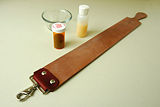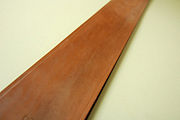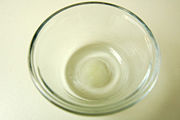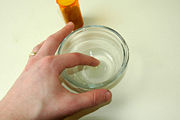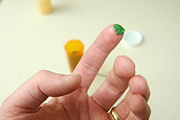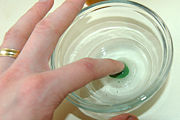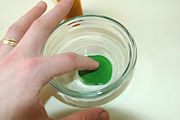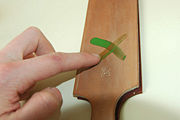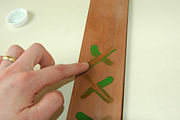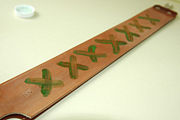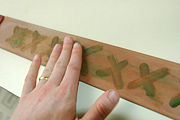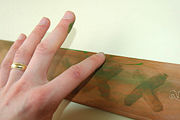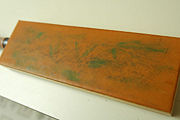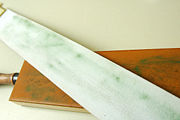Pasting a strop - a photo tutorial
Originally posted by Josh Earl.[1].
When I was starting out, I had lots of questions about pasted strops. I decided to paste one of my hanging strops today, so I thought I'd take the opportunity to put together a quick photo tutorial.
You can paste just about any type of strop. Paddle strops are the most common, but I've come to favor hanging strops. I like to paste one side of the linen on my hanging strops. If you need to touch up your razor, you just take the screw out, flip the linen around and do a few laps.
The advantage of pasted paddles is that the rigid surface makes it less likely that you'll have a mishap and wipe out the edge. Pasted hanging strops, though, are really fast to use. I find that pasted hanging strops are less likely to overhone an edge, and the edges to me seem to last longer than the edges from pasted paddles.
I'll be applying powdered chromium oxide to the horsehide side of my Tony Miller sharpening strop. The medium we'll use to get the powder onto the leather is strop dressing. This bottle came with my strop; I think Tony recommends Lexol. You could use neatsfoot oil or another leather conditioner to achieve the same thing.
The untreated horsehide is almost slick to strop on--it should make a nice surface to apply the paste to. I think it's best to avoid trying to paste latigo, but most other leathers should work pretty well.
I put a few drops of strop dressing in my little mixing bowl. For some surfaces, like linen, I've used water instead of strop dressing to get the powder to adhere. I once pasted a balsa paddle using mineral oil, and it turned out pretty well.
I dip my finger in the dressing...
- Preparing the strop
And then dip it into the powdered abrasive.
My favorite paste is .5 micron chromium oxide powder from HandAmerican.com. I've used diamond pastes and Dovo's red and black pastes, but I always come back to the chromium oxide. It imparts a silky smoothness to the edge--it's the quickest route to that "velvet squeegie" effect you might have read about.
Diamond edges are sharp but harsher feeling to me. The Dovo pastes work well, but the black paste doesn't create quite as sharp of an edge in my opinion. I do still use it from time to time, as some razors just like it better...
I mix the powder into the dressing...
- Mixing up powder
Now this is important:
That green paint looks really purdy, doesn't it? Like finger paint, almost. It's really tempting to just start smearing it everywhere on your strop. My first few strops looked like pool tables--all nice and green and even.
And they dulled edges every time I used them. I couldn't get a decent shave off any of my pasted strops.
So, regardless of the type of paste you're applying, GO EASY. You can always add more later. I find that my favorite level of paste is where you can just barely tell it's pasted at all. A little abrasive goes a LONG way.
To avoid getting mesmerized by the fun green fingerpaint, I let my inner toddler draw a series of X's on the strop. Don't try to make them really heavy or even. Go lightly.
I was taking pictures while I was pasting, and I'm actually thinking I might have overdone this one a bit...
- First steps
Now we'll just smear the paste around a little bit. I like to add a little more to the edge of the strop on the razor side, if that makes sense. I want to make sure the heel and toe are going to hit pasted leather, too.
- Smearing the paste around a little bit
Here's the finished strop. The paste looks heavier than it actually is, because the strop dressing hasn't absorbed yet.
I'm also including photos of my pasted paddle and a pasted linen strop. See how you can barely see the green on the linen? That's ideal. (A lot of the color you see on the paddle is actually metal residue, not paste.)
This same basic approach works well for other pastes as well. For diamond compounds, which come in paste form already, I'd recommend applying a tiny dab every few inches, then smearing it around. Remember, you don't want to cover the surface, so a little bit is all you need.
- Finished strop
After lots of experimenting, I find that a pasted hanging strop works best for maintaining my own razors. (I go easy on the pastes for razors sent to me for honing. Not everybody likes pasted strop edges--some guys find they don't last as long.)
Coming off the coticule, I might do 10 to 40 laps on a pasted hanging strop. With so little paste on the strop, I don't have trouble with overhoning or killing the edge.
When I need a touchup, five to 10 quick laps will get me shaving happily again.
